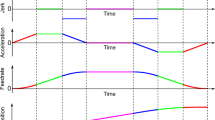Abstract
This paper discusses the singular problem in five-axis machining of freeform surfaces. At first, the generating mechanism of the singularities is studied on the unit sphere in the P-system. Then a new method is developed to avoid the singularities by translating the tool orientations in the configuration-space (C-space) at the time just after the initial cutter locations have been generated for a cutter contact (CC) trajectory on the surface. The tool orientation vectors of the initial cutter locations are projected onto the C-space, forming the orientation polyline. In the C-space, a taper circle is defined. The singularities are detected by contact checking between the orientation polyline and the taper circle. Once they contact, the orientation polyline is translated by a minimum translating vector to avoid the contact. The minimum translating vector is picked on the offset polyline of the original orientation polyline. After that, the translated orientation polyline is inversed to calculate the optimized cutter locations in the P-system. The benefit of avoiding singularities at the tool path planning stage is that the original CC points on the CC trajectory are respected. The developed method is programed and tested through contrastive experiments. Results show that the optimized cutter locations can effectively avoid the singularities.
Similar content being viewed by others
References
Castagnetti C, Duc E, Ray P (2008) The domain of admissible orientation concept: a new method for five-axis tool path optimisation. Comput Aided Des 40(9):938–950
Ülker E, Emin Turanalp M, Selçuk Halkaci H (2009) An artificial immune system approach to CNC tool path generation. J Intell Manuf 20(1):67–77
He W, Lei M, Bin H (2009) Iso-parametric CNC tool path optimization based on adaptive grid generation. Int J Adv Manuf Technol 41(5–6):538–548
Ding S, Mannan MA, Poo AN, Yang DCH, Han Z (2005) The implementation of adaptive isoplanar tool path generation for the machining of free-form surfaces. Int J Adv Manuf Technol 26(7–8):852–860
Feng H-Y, Teng Z (2005) Iso-planar piecewise linear NC tool path generation from discrete measured data points. Comput Aided Des 37(1):55–64
Lee Y-S (1998) Non-isoparametric tool path planning by machining strip evaluation for 5-axis sculptured surface machining. Comput Aided Des 30(7):559–570
Tournier C, Duc E (2005) Iso-scallop tool path generation in 5-axis milling. Int J Adv Manuf Technol 25(9–10):867–875
Rao N, Ismail F, Bedi S (1997) Tool path planning for five-axis machining using the principal axis method. Int J Mach Tools Manuf 37(7):1025–1040
Rao N, Ismail F, Bedi S (2000) Integrated tool positioning and tool path planning for five-axis machining of sculptured surfaces. Int J Prod Res 38(12):2709–2724
Gray PJ, Bedi S, Ismail F (2005) Arc-intersect method for 5-axis tool positioning. Comput Aided Des 37(7):663–674
Warkentin A, Ismail F, Bedi S (1998) Intersection approach to multi-point machining of sculptured surfaces. Comput Aided Geom Des 15(6):567–584
Gray P, Bedi S, Ismail F (2003) Rolling ball method for 5-axis surface machining. Comput Aided Des 35(4):347–357
Gray PJ, Ismail F, Bedi S (2004) Graphics-assisted rolling ball method for 5-axis surface machining. Comput Aided Des 36(7):653–663
Balasubramaniam M, Sarma SE, Marciniak K (2003) Collision-free finishing toolpaths from visibility data. Comput Aided Des 35(4):359–374
Tang TD, Bohez ELJ, Koomsap P (2007) The sweep plane algorithm for global collision detection with workpiece geometry update for five-axis NC machining. Comput Aided Des 39(11):1012–1024
Lin Z, Shen H, Gan W, Fu J (2012) Approximate tool posture collision-free area generation for five-axis CNC finishing process using admissible area interpolation. Int J Adv Manuf Technol 62(9–12):1191–1203
Bi Q-Z, Wang Y-H, Ding H (2009) A GPU-based algorithm for generating collision-free and orientation-smooth five-axis finishing tool paths of a ball-end cutter. Int J Prod Res 48(4):1105–1124
Wang QH, Li JR, Zhou RR (2006) Graphics-assisted approach to rapid collision detection for multi-axis machining. Int J Adv Manuf Technol 30(9):853–863
Lasemi A, Xue D, Gu P (2010) Recent development in CNC machining of freeform surfaces: a state-of-the-art review. Comput Aided Des 42(7):641–654
Ho M-C, Hwang Y-R, Hu C-H (2003) Five-axis tool orientation smoothing using quaternion interpolation algorithm. Int J Mach Tools Manuf 43(12):1259–1267
Affouard A, Duc E, Lartigue C, Langeron JM, Bourdet P (2004) Avoiding 5-axis singularities using tool path deformation. Int J Mach Tools Manuf 44(4):415–425
Sørby K (2007) Inverse kinematics of five-axis machines near singular configurations. Int J Mach Tools Manuf 47(2):299–306
Anotaipaiboon W, Makhanov SS, Bohez ELJ (2006) Optimal setup for five-axis machining. Int J Mach Tools Manuf 46(9):964–977
Pessoles X, Landon Y, Segonds S, Rubio W (2013) Optimisation of workpiece setup for continuous five-axis milling: application to a five-axis BC type machining centre. Int J Adv Manuf Technol 65(1–4):67–79
Mansor MSA, Hinduja S, Owodunni OO (2006) Voronoi diagram-based tool path compensations for removing uncut material in 2½D pocket machining. Comput Aided Des 38(3):194–209
Kimmel R, Bruckstein AM (1993) Shape offsets via level sets. Comput Aided Des 25(3):154–162
Choi BK, Park SC (1999) A pair-wise offset algorithm for 2D point-sequence curve. Comput Aided Des 31(12):735–745
Lin Z, Fu J, He Y, Gan W (2013) A robust 2D point-sequence curve offset algorithm with multiple islands for contour-parallel tool path. Comput Aided Des 45(3):657–670
Liu X-Z, Yong J-H, Zheng G-Q, Sun J-G (2007) An offset algorithm for polyline curves. Comput Ind 58(3):240–254
Author information
Authors and Affiliations
Corresponding author
Rights and permissions
About this article
Cite this article
Lin, Z., Fu, J., Shen, H. et al. Non-singular tool path planning by translating tool orientations in C-space. Int J Adv Manuf Technol 71, 1835–1848 (2014). https://doi.org/10.1007/s00170-014-5629-6
Received:
Accepted:
Published:
Issue Date:
DOI: https://doi.org/10.1007/s00170-014-5629-6




